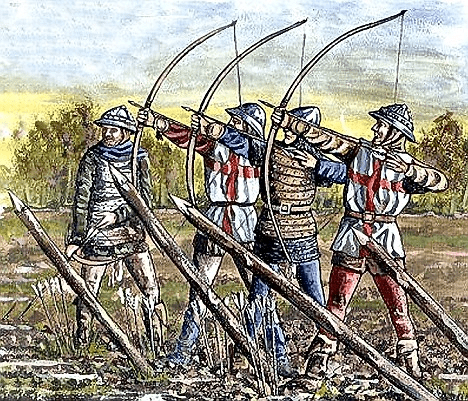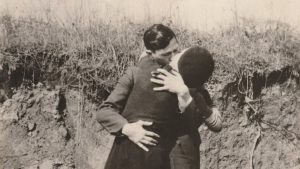On October 25, 1415, English King Henry V led his men into the battle that would give England the upper hand in the English/French conflict that would become known as the Hundred Years’ War. He was at the very center of the cavalry formation, personally pressing his men forward. His small army of skillful warriors was prepared to give everything it had to protect its king and nation’s reputation. Henry V’s dedication to his country’s image was very evident in the amount of time he put into his strategy and training for his men. As the English army advanced toward the swarming French forces, which was more than triple their size, King Henry reminded his troops to always fall back on their training and to fight until the very end. Henry V gave the army one last morale boost, reminding his men what they were doing for England, before participating in one of the most gruesome battles that the fifteenth century world had ever witnessed.1

The legendary battle ran much deeper than a simple feud or declaration of war. Instead, it was fought over King Henry V’s blood-right to rule France through his great-grandfather Edward III’s claim through his French mother, Princess Isabella. After Henry’s official accession to the throne, he inherited the entire royal army, for which he had great plans. Following his coronation, he began taking greater initiative involving foreign policy than his predecessor, and intended to take an offensive against the French. His goal was to outdo his father, and to restore England’s lost glory, which had eroded over the failed battles of 1412. His will to prove himself in battle primarily stemmed from the fact that he had many enemies within his own court. There were those who, if rumor was to be believed, were looking to overthrow him. He soon established more support within several provinces such as Guienne, making his old family friend, Earl of Dorset, the Lieutenant of Guienne, where Henry funded the training of men-at-arms and archers, which he predicted would be needed to win Agincourt. For hours, the Earl of Dorset trained the archers on their accuracy, technique, and plan of attack.2
Henry V quickly began working on improving his already impressive army, as he considered it to be the backbone of his entire authority. He strengthened his combatants by providing them with new logistics and knowledge about combat, and created entire battalions of Longbowmen to counteract France’s tendency to rely on large numbers of well-trained knights. Henry V personally appointed Longbowmen specialists to condition his Longbowmen, and devised a cunning plan to out strategize the French. Henry V was stubborn and determined to win, and he often made use of whatever cutting-edge techniques or technology that he could get his hands on. He began creating an overarching war plan: something revolutionary for the era. Most wars followed similar patterns, while Henry V came up with a whole new route to attack, and plan of attack with a new killer formation.3 He trained and prepared his troops to adapt quickly to different movements and formations, and made sure that his Longbowmen could fire on multiple groups of targets simultaneously. He did everything in his power to prepare his soldiers for war and conquest.4

In the final stage of preparation, Henry V began forcefully taking land and supplies from the French, and embarked on one of his most daring missions: sailing across the Bay of the Seine to Port Harfleur, which was very strategic positioning to begin his march to face the French. This allowed Henry the opportunity to seize supplies from the French for England’s troop’s long journey ahead.5 However, after the Siege of Harfleur earlier in 1415, Henry’s forces were unable to replenish as much of their supplies as they would have liked. Henry V’s forces and supplies were limited by the space in their boats and what they could commandeer from the French, which reversed most of Henry V’s progress, and they took more casualties when the English confronted the French for supplies. The English faced the overwhelming numbers of the French compared to Henry V’s small band of warriors left. The number of French present ranged from the thousands to the millions according to the different accounts from the time, leaving historians only able to guess the actual number of French that opposed the English. Historians now can only speculate about the true numbers. The only thing that could prevent the defeat of the English was their skill with the Longbow and the English’s formation. Henry V hoped his new strategy and weaponry would give him some means to fend off against his enemy. Henry V had a dwindling army compared to the French’s knights in armor. His soldiers were disciplined, but few. Would they be able to execute their plan of attack and withstand the French’s force?6
There was some time before the conflict commenced when the French were taunting the English to begin the battle, since they were so outnumbered. After the English advanced their forces, the French Army charged into the middle ground. A key factor that was not considered was the location of the battle and the weather leading up to it. One problem with these factors was the place where the Agincourt battle was located. It was between two tree-lines, with its fields muddied from storms from the previous night leading up to the battle. This caused it to be hard for many of the men and horses to keep their footing, making most knights dismount. Some lost their horses in the mud.

As the French continued to advance, the English longbow men fired into the mass of French soldiers. This caused some French soldiers to fall out of ranks, and others more heavily armored fell down, and others were unable to rise and drown in the growing mounds of bodies. Another advantage of the English was their ability to maneuver easily, as their gear was made up of simple leather or minimal metal armor, while the French knights had trouble crossing the mud, thanks to their full coats of armor. After the English shot all their arrows into the masses of clumsy dismounted knights and foot soldiers, the English advanced further and the longbowmen use hatchets and hand-to-hand weapons to strike down those who have not already fallen into the growing mound of bodies. When the longbowmen ran out of arrows and the French advanced, they took out their short hand weapons to bludgeon the lasting enemy who had not already retreated. As the English struggled to keep their formation, as the chaos of the battle ensued for hours, the English’s prayers were answered. The French began to retreat! This unlikely victor rose awestruck, proving that practice makes perfect and investing in the latest technology pays off. Although this battle did not give the English the strength to win the war, this victory restored the public’s view of Henry V and showed the English people that he was a great leader in that moment.7
This battle was one of the more gruesome in history, leaving many of the warriors on both sides wounded. However, this battle is still used today as an example of strategic mastermind. Military strategists from West Point still teaches these techniques today. While we have progressed past Longbows, the grit and courage of the soldiers have proven to cause more success than sheer numbers. Many use this battle as an example of when a small army with a plan and modern technology can beat a large chaotic and unorganized one. This battle also showed how the leader’s attitude must be the model for his troops. Henry’s charismatic leadership skills greatly affected the English’s victory, and this has inspired many battle tactics and mental exercises modern military use today, including the U.S.8
- Anne Curry, The Battle of Agincourt (London: Yale University Press, 2015), 196-198. ↵
- Anne Curry, The Battle of Agincourt (London: Yale University Press, 2015), 196-204. ↵
- Jan Honig, “Reappraising Late Medieval Strategy: The Example of the 1415 Agincourt Campaign,” War in History 19, no. 2 (2012): 131-132. ↵
- Jan Honig, “Reappraising Late Medieval Strategy: The Example of the 1415 Agincourt Campaign,” War in History 19, no. 2 (2012): 124-125. ↵
- John Keegan, The Face of Battle (New York: Viking Press, 1976), 81. ↵
- Anne Curry, The Battle of Agincourt (London: Yale University Press, 2015), 196-204. ↵
- Jan Honig, “Reappraising Late Medieval Strategy: The Example of the 1415 Agincourt Campaign,” War in History 19, no. 2 (2012): 131. ↵
- Jan Honig, “Reappraising Late Medieval Strategy: The Example of the 1415 Agincourt Campaign,” War in History 19, no. 2 (2012): 123-124. ↵




21 comments
Elliot Avigael
This article caught my eye because I loved the movie “The King” featuring Timothee Chalamet. It is for this battle alone that I believe the young king Henry V to be one of England’s most impressive monarchs. Big armies are intimidating with their large numbers, but are usually very clumsy to maneuver and handle.
The most incredible of military feats have always been achieved against the odds, by small armies. It is always about the fighting spirit and strategy and less about numbers.
Very well done article, and very interesting.
Joshua Collins
Malleigh, wonderfully written article. Henry the 5th and the Battle of Agincourt will always be one of the most famous victories in English history. I was interested to discover that Agincourt was a planned battle site as opposed to one that just happened out of necessity. The amount of training that you speak of for Henry’s long bowmen must have been a brutal endeavor. Knowing that you and your quiver of arrows was all you had against incredible numbers of mounted and unmounted soldiers must have been a sobering experience to say the least. However, as history shows the skill of these long bowmen won the day for the English and Henry V.
Giselle Garcia
This article was very interesting to read about how King Henry V used an ingenious military strategy on how to defeat the French in battle. His army had a great amount of strength through their archery skills and their special formation. The English army demonstrated that they didn’t need to have great numbers of men, but through a well-strategized plan and use of intelligent military tactics resulted in a victorious battle against their enemy.
Anthony Coronado
How the battle commenced was far from over, it shows that the conditions and weather do play a factor war. Such as the equipment that the armies used was a contributing factor as well as the types of troops on the field, such as the skilled English longbowmen to french armored foot-soldiers/ calvary.
Amanda Shoemaker
It’s very cool to think that mental tactics used in the 1400’s by King Henry V are still tactics used in militaries today. I recently watched a movie about King Henry V based on this time in his life and it’s very interesting that most of it was true. All of his victories seem to be based on the fact that he wanted to prove everyone that doubted him wrong. I really enjoyed this article and all of the facts based around King Henry V.
Melissa Garza
This is a very well structured and informative article. I found it really interesting that King Henry V was able to defeat the French with very little numbers and with little equipment in the Battle of Agincourt. Though many lives were lost and wounded on both sides, it was really a great example, as stated, of strategic excellence. It was especially interesting to find out that many military personnel in West Point still use strategies from the battle today.
Alondra Lozano
It is really great as to how king Henry V was able to defeat the French with a small army. It is not about numbers it is about thinking smarter than the opponent and that is what King Henry V did. He used his resources by obtaining the latest technology and used them to his advantage. It is really interesting that his strategies and tactics are still being used.
Nathaniel Bielawski
King Henry’s strategy proves that up to date technology and well trained soldiers make up the best armies. The Battle of Agincourt demonstrates that well equipped soldiers don’t necessarily make up good armies. I hope that the U.S. Military and it’s allies study the Battle of Agincourt as an example of great battle tactics.
Sara Guerrero
I think it’s amazing that the small army of King Henry V could beat the large army of the French. It shows that you shouldn’t underestimate anyone and, although many lives were lost, the ideas and tactics of King Henry V show his understanding of the environment and taking into consideration anything that could affect a battle. I think Henry’s knowledge and success in this battle modernized today’s battle strategies.
Davis Nickle
Henry V really showed the French that you don’t necessarily need numbers and brute strength to win a battle. He made everything work for him during Agincourt. Whether it was the long bowmen’s superiority, the terrain, or his men’s maneuverability, he made sure everything favored him without the French even knowing it. It really goes to show that even when the odds are stacked against you preparation and cunning can easily turn the tables in your favor.